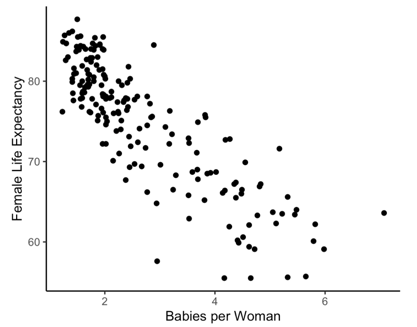Data from gapminder.org on 184 countries was used to examine if there is an association between (average) female life expectancy (that is, the average lifespan of women in the country) and the average number of children women give birth to for the year 2019. A scatterplot of the data follows. 
-The p-value for this test is less than 0.001. What can we conclude?
A) We have strong evidence that average number of children per woman is associated with female life expectancy.
B) We have strong evidence that an increase in average number of children per woman will decrease female life expectancy.
C) We have strong evidence that an increase in female life expectancy will decrease the average number of children per woman.
D) We have strong evidence that average number of children per woman is not associated with female life expectancy.
Correct Answer:
Verified
Q21: Data from gapminder.org on 184 countries was
Q22: Data from gapminder.org on 184 countries was
Q23: Data from gapminder.org on 184 countries was
Q24: Data from gapminder.org on 184 countries was
Q25: Data from gapminder.org on 184 countries was
Q27: The following scatterplot displays the finish time
Q28: The following scatterplot displays the finish time
Q29: The following scatterplot displays the finish time
Q30: The following scatterplot displays the finish time
Q31: If you fit a least squares line
Unlock this Answer For Free Now!
View this answer and more for free by performing one of the following actions

Scan the QR code to install the App and get 2 free unlocks

Unlock quizzes for free by uploading documents